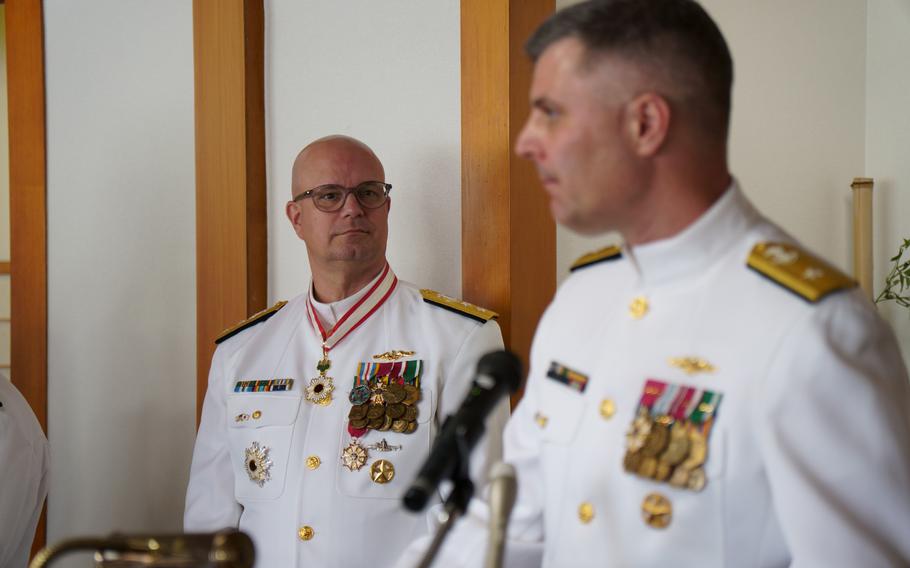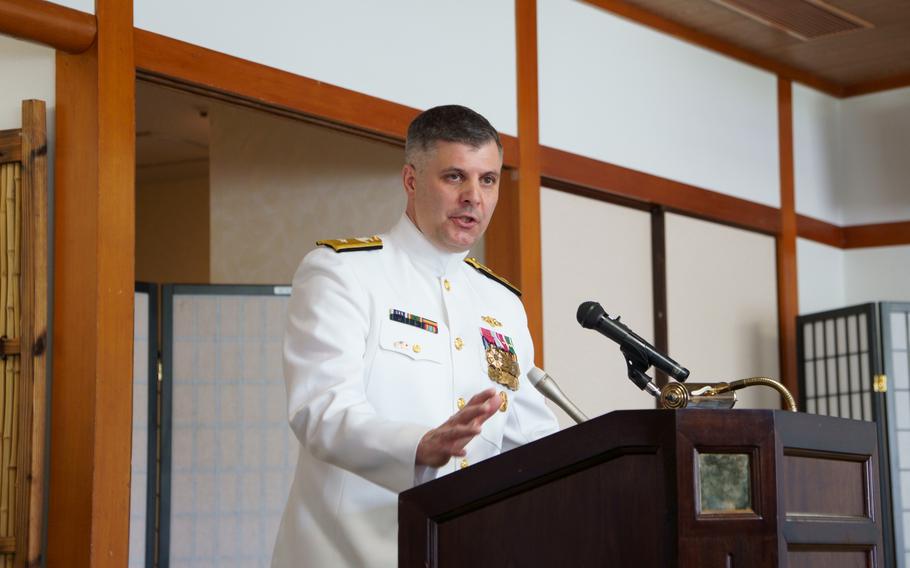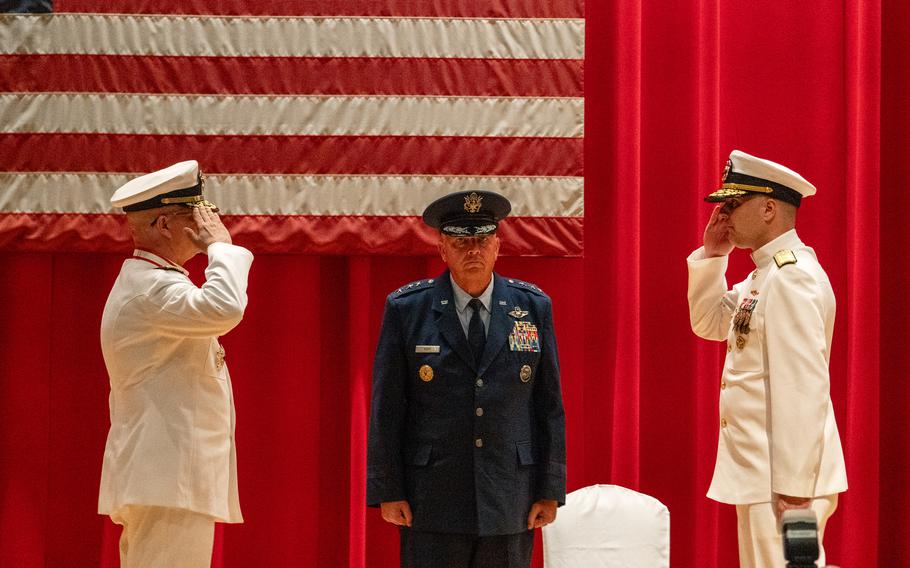
Rear Adm. Ian Johnson, right, answers questions from the media next to his predecessor, Rear Adm. Carl Lahti, after a change of command ceremony at Yokosuka Naval Base, Japan, June 26, 2024. (Akifumi Ishikawa/Stars and Stripes)
YOKOSUKA NAVAL BASE, Japan — The strength of the U.S.-Japan alliance — and the threats of Chinese and Russian activity in the region — were front and center Wednesday as a seasoned submariner took responsibility for all U.S. Navy bases in Japan.
Hundreds gathered that morning at Yokosuka’s Fleet Theater to see Rear Adm. Ian Johnson relieve Rear Adm. Carl Lahti as commander of Naval Forces Japan and Navy Region Japan.
Johnson, who most recently served as commander of Navy Region Southeast at Naval Air Station Jacksonville, Fla., did not mention China or Russia by name. Instead, he emphasized that regional security depends on the U.S.-Japan alliance and other partners.
“It’s not necessarily the ships, or the aircraft, or the buildings or the weapons,” he said during the ceremony. “It’s the people that make us strong, a team of teams built on relationships developed over time, over many decades.”

Rear Adm. Ian Johnson speaks with reporters after assuming command of U.S. Naval Forces Japan and Navy Region Japan at Yokosuka Naval Base, Japan, June 26, 2024. (Akifumi Ishikawa/Stars and Stripes)
The dual-hatted command carries diverse responsibilities, including coordinating with the Japan Maritime Self-Defense Force, authority over shore-based Navy assets and the administration of five U.S. Navy bases in Japan, another on Diego Garcia and a tenant command in Singapore.
Those responsibilities comprise a “vital role” in the defense of Japan and the Indo-Pacific region, particularly against “routine incursions into sovereign territory” from China and Russia’s determination to “assert itself” in the northern Pacific, according to Air Force Lt. Gen. Ricky Rupp, commander of U.S. Forces Japan.
The two countries are “intent on destroying the current status quo and asserting their presence in a region increasingly pivotal to global economic security,” he said during the ceremony.
Lahti, who will next command Navy Region Mid-Atlantic in Norfolk, Va., echoed those sentiments and added that an “increasingly intrusive” Beijing is “using expansionist claims” and “brazen tactics,” especially in areas like Second Thomas Shoal.

Rear Adm. Carl Lahti, left, and Rear Adm. Ian Johnson, right, salute in front of Lt. Gen. Ricky Rupp during a change of command ceremony for U.S. Naval Forces Japan and Navy Region Japan at Yokosuka Naval Base, Japan, June 26, 2024. (Akifumi Ishikawa/Stars and Stripes)
The reef, located in the contested Spratly Islands in the South China Sea, is claimed by multiple countries but has remained a flashpoint between China and the Philippines, another U.S. ally.
Lahti, Rupp and Adm. Ryo Sakai, head of the Japan Maritime Self-Defense Force, also cited North Korea as a threat in the region. Sakai noted an increase in Russian and Chinese military activity around Japan and continued missile development from North Korea during Lahti’s tenure.
“Under such circumstances, the relationship between Japan and the United States has been extremely important for the security of the international community, especially in the Indo-Pacific region,” Sakai said during the ceremony.
Johnson has been tracking his new command for years and feels he’s in an ideal position to continue strengthening the ties between the Navy and Japan Maritime Self-Defense Force, he told Stars and Stripes at a news conference after the ceremony.
“I think we are on target for where we need to go,” he said. “My intention is to progress those efforts and do the same type of engagements that we’ve been doing to this point.”
Johnson served aboard at least four submarines, including as executive officer for the attack submarine USS Memphis and commander of the attack submarine USS Connecticut.
Originally from Wakefield, R.I., he graduated from the U.S. Naval Academy in 1994 with a bachelor’s in aeronautical engineering. He also holds a master’s in engineering management from Catholic University of America.